Blenders are a staple in modern kitchens, helping create everything from smoothies and soups to baby food and sauces. However, not all blenders are created equal, especially when it comes to the materials used in their construction. In this guide, we’ll explore the importance of non-toxic blenders and why they’re a must-have for a healthier kitchen.
8 Best Non-Toxic Blenders
Investing in a high-quality, non-toxic blender can be a game-changer for your kitchen and health. Here are the top brands and models available today, along with their pros and cons to help you make an informed decision.
Breville the Fresh and Furious Countertop Blender
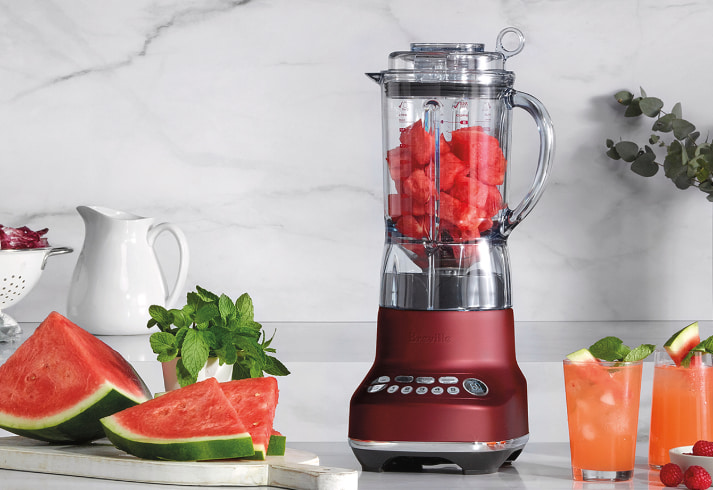
The Breville Fresh and Furious Countertop Blender is a versatile kitchen appliance designed for both everyday and high-performance blending needs. With its commitment to user-friendly design and innovative technology, this blender has become a popular choice for those seeking efficient and effective food preparation while maintaining an eco-conscious approach.
This blender stands out for its non-toxic materials, ensuring no harmful chemicals leach into your food. The pitcher is BPA-free, which is a vital feature for health-conscious consumers. Breville also emphasizes energy efficiency in its appliances, reducing environmental impact during operation.
The blender is equipped with a powerful 1100-watt motor and five pre-programmed settings, allowing for effortless blending of smoothies, soups, and even crushing ice. Its surgical-grade stainless steel blades ensure durability and precision, while the quiet motor makes it less disruptive compared to many competitors. The LCD display with an auto-timer adds a touch of convenience, letting you keep track of blending time with ease.
Breville incorporates a unique Kinetix blade and bowl system, which combines the functions of a traditional blender and food processor. This innovative approach ensures consistent textures, reducing the need for re-blending. The sturdy base and ergonomic design further enhance stability and ease of use.
In terms of sustainability, Breville has taken steps to use recyclable packaging and promote energy-efficient appliances. However, the device does not feature compostable parts or a take-back program for end-of-life disposal, which some eco-conscious consumers may prefer.
Pros:
- BPA-free, non-toxic pitcher ensures food safety.
- Powerful motor handles various tasks efficiently.
- Quiet operation compared to many blenders.
- Kinetix blade system delivers consistent textures.
- LCD display with auto-timer for precise blending.
- Recyclable packaging supports sustainability.
Cons:
- Lacks a take-back program for disposal.
- Limited compostable or biodegradable components.
- Higher price point compared to similar blenders.
Hamilton Beach Blenders
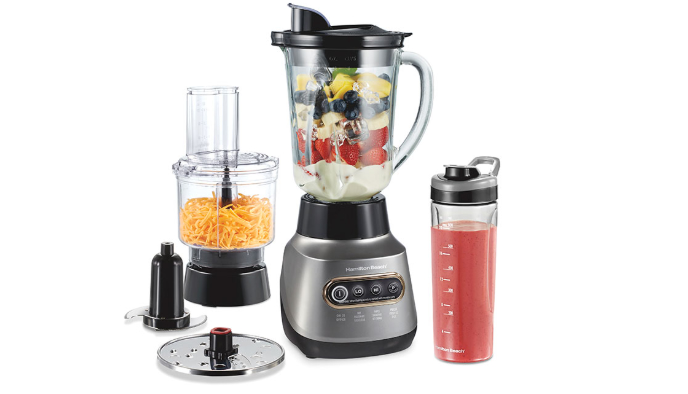
The Hamilton Beach Blenders are versatile and practical choice for individuals seeking a durable and eco-friendly blending solution. Made from tempered glass, this jar is designed for daily use, offering a sustainable alternative to plastic containers while maintaining excellent functionality.
The glass jar is a standout feature, as it avoids the potential chemical leaching associated with plastic and is fully recyclable at the end of its life. It’s also resistant to stains and odors, ensuring your smoothies, soups, or sauces retain their intended flavors. The material’s durability allows it to withstand both high and low temperatures, making it suitable for hot and cold blending tasks.
In terms of design, the jar includes clear measurement markings, enabling precise portion control, and a wide-mouth opening that simplifies pouring and cleaning. The jar is compatible with most Hamilton Beach blender bases, making it an easy upgrade or replacement part for existing users.
While the product does not carry certifications such as BPA-free labeling (as glass is inherently free from BPA), it would benefit from clearer information on its manufacturing process, such as whether the glass is sourced sustainably or made in an energy-efficient facility.
For users who prioritize non-toxic kitchenware, the Hamilton Beach Blender offers peace of mind with its health-conscious design, but additional details about its environmental impact would enhance its appeal further.
Pros:
- Made from tempered glass, ensuring durability and recyclability.
- Naturally non-toxic and free from harmful chemicals like BPA.
- Resists stains and odors, preserving food flavors.
- Heat- and cold-resistant, suitable for versatile blending tasks.
- Clear measurement markings for convenience.
- Wide-mouth opening for easy pouring and cleaning.
Cons:
- Lack of detailed information on the sustainability of the manufacturing process.
- Limited to compatibility with Hamilton Beach blender bases.
Oster Blenders
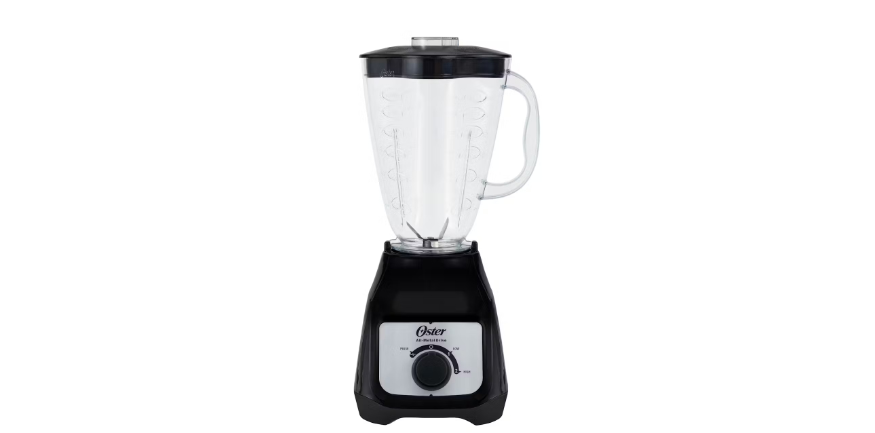
The Oster Blenders are designed as a durable, eco-friendly replacement or upgrade for your Oster blender. Whether you’re replacing a worn-out jar or seeking a more sustainable alternative to plastic, this glass jar offers a sleek and practical solution that prioritizes safety and environmental responsibility.
Main Features:
- Non-toxic materials: Made from high-quality, BPA-free glass, ensuring safe food preparation without the risk of leaching chemicals.
- Eco-friendly design: Glass is fully recyclable and long-lasting, reducing waste compared to plastic alternatives.
- Generous capacity: Holds up to 6 cups, perfect for making smoothies, soups, and sauces for family-sized portions.
- Universal compatibility: Fits most Oster blender bases, making it an easy and hassle-free replacement.
- Stain-resistant and easy to clean: The non-porous glass resists odors and stains, ensuring your jar stays fresh and hygienic.
For anyone serious about blending, the Oster Blender offers a thoughtful combination of safety and sustainability. The non-toxic glass ensures that no harmful chemicals make their way into your food, a concern often associated with older or lower-quality plastic jars. Glass is also naturally resistant to scratches, maintaining its clarity over time, even after frequent use.
The jar’s 6-cup capacity makes it ideal for preparing large batches of smoothies, purees, or even frozen cocktails. It’s particularly useful for families or households that enjoy frequent blending, offering enough space to prepare multiple servings in one go. The glass construction also provides a noticeable heft, which lends stability when blending tough ingredients like ice or frozen fruit.
Cleaning is a breeze with this jar, thanks to its smooth, non-porous surface that resists stains and odors. You’ll appreciate how quickly it rinses out after use, and it’s dishwasher-safe for added convenience. Additionally, the design’s compatibility with most Oster blender bases means you don’t have to worry about finding the right fit.
Pros:
- Made from BPA-free, durable glass for non-toxic and eco-friendly use.
- Fully recyclable and more sustainable than plastic.
- Large 6-cup capacity ideal for family-sized recipes.
- Easy to clean and dishwasher-safe.
- Resistant to stains, odors, and scratches.
- Universal fit with most Oster blender bases.
Cons:
- Heavier than plastic jars, which may not be ideal for those seeking lightweight options.
- Glass can break if dropped, requiring careful handling.
- Lacks measurement markings for precise ingredient measuring.
BLACK+DECKER PowerCrush Multi-Function Blender
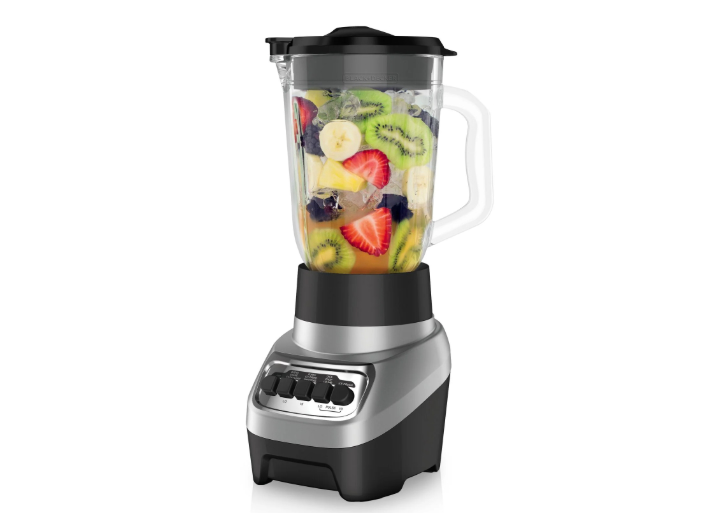
The BLACK+DECKER Blender is an affordable and versatile appliance designed for home cooks seeking efficiency and ease of use. This blender boasts a 700-watt motor, four preset functions, and a 6-cup glass jar, making it suitable for a range of tasks from crushing ice to pureeing smoothies. Its quad-pro blade technology ensures even blending, while the dishwasher-safe parts simplify cleanup.
In terms of environmental considerations, the glass jar is a sustainable feature compared to plastic alternatives, as it is durable and recyclable. However, the product does not emphasize eco-friendly materials or certifications in its design. The plastic components, while BPA-free, are not made from recycled materials. Additionally, the blender’s energy efficiency is standard but lacks features like automatic shutoff to conserve power.
Performance-wise, the PowerCrush delivers consistent results for basic blending needs. However, it struggles slightly with tougher ingredients like frozen fruits or nuts compared to higher-end models. It is ideal for light to medium use, making it a solid choice for those on a budget who need a dependable kitchen tool.
Pros:
- Affordable and versatile with multiple functions.
- Durable glass jar enhances sustainability and usability.
- Easy to clean with dishwasher-safe parts.
Cons:
- Lacks eco-friendly certifications or sustainable plastic use.
- Struggles with harder ingredients under heavy use.
- Standard energy efficiency without advanced features.
Dash Quest Countertop Blender
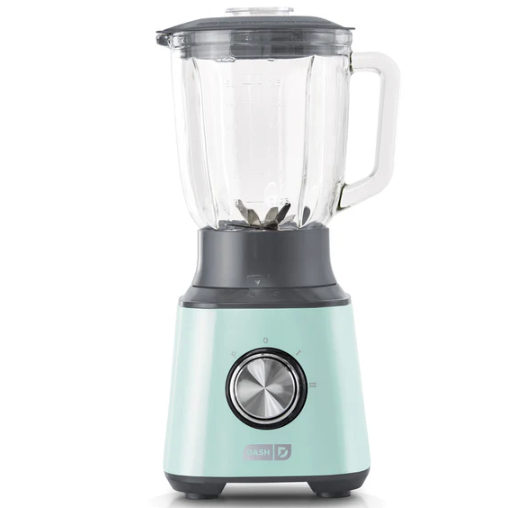
The Dash Quest Countertop Blender is a compact, budget-friendly appliance designed for quick blending tasks. It is particularly well-suited for small kitchens, personal use, or light meal prep. Its focus on simplicity and functionality makes it an appealing choice for consumers seeking an affordable and straightforward blender.
The blender features a BPA-free plastic blending jar, ensuring that it is non-toxic and safe for food contact. This is a critical consideration for those prioritizing health-conscious choices in their kitchen appliances. With a modest 1.5 horsepower motor, it can handle smoothies, soups, and sauces with relative ease, though it may struggle with harder ingredients like frozen fruits or ice.
A standout feature is its compact design, making it easy to store in tight spaces. The straightforward controls—limited to a few speed settings—offer ease of use for beginners and those looking for minimal fuss. Additionally, the blender jar and blade are dishwasher-safe, which is a convenient feature for hassle-free cleanup.
While the Dash Quest Countertop Blender lacks advanced features like pre-programmed settings or high power, it is an eco-conscious choice due to its energy efficiency and BPA-free components. However, it may not meet the needs of users who require a blender capable of handling heavy-duty tasks or prolonged usage.
Pros:
- Compact and lightweight, ideal for small kitchens or personal use.
- BPA-free plastic jar ensures non-toxic food safety.
- Easy to operate with straightforward controls.
- Dishwasher-safe components simplify cleaning.
- Energy-efficient, making it an eco-friendly option.
Cons:
- Limited motor power struggles with tougher ingredients like frozen fruit or ice.
- Lacks advanced features such as pre-programmed settings or variable speeds.
- Not suitable for heavy-duty or prolonged blending tasks.
- Smaller jar capacity may not accommodate larger servings or family-sized portions.
Vitamix Blenders
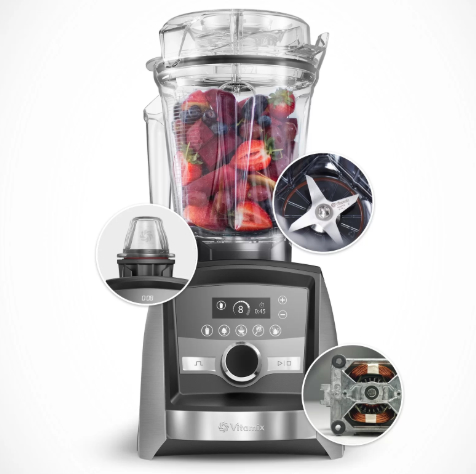
The Vitamix Blenders have become a staple in many eco-conscious kitchens, celebrated for its powerful performance, durability, and versatility. Designed to handle everything from smoothies to soups, this blender is built to last while emphasizing sustainable, non-toxic materials.
- Main Features:
- High-performance motor capable of blending tough ingredients like nuts and seeds.
- BPA-free container made from non-toxic, food-safe materials.
- Variable speed control for precision blending.
- Self-cleaning function for convenience and water efficiency.
- Durable stainless steel blades designed for long-term use.
- Designed with sustainability in mind, minimizing the need for replacements.
Why the Vitamix Blender Stands Out
One of the key reasons Vitamix is often considered the gold standard for blenders is its exceptional durability. Unlike many other blenders that wear out after a few years, the Vitamix is designed to last decades with proper care. This reduces waste, as you’re less likely to send broken appliances to the landfill. Additionally, the BPA-free construction ensures your food stays free from harmful chemicals, making it a safer choice for you and your family.
The versatility of the Vitamix Blender is another major selling point. From creating silky-smooth nut butters to hot soups (thanks to the friction of the blades), it’s an all-in-one tool for anyone looking to streamline their kitchen appliances. It can even make dough and crush ice with ease, reducing the need for multiple devices.
In terms of eco-friendliness, Vitamix takes a thoughtful approach to manufacturing. While not explicitly zero-waste, the company prioritizes durable materials and offers repair services, which is a refreshing alternative to the disposable appliance culture.
The Vitamix Blender is perfect for individuals and families who value healthy eating and want a dependable, long-lasting tool for their kitchen. It’s also a great investment for those who love experimenting with homemade foods, such as plant-based milks, vegan cheeses, or fresh sauces. Its self-cleaning feature makes it especially appealing for busy households aiming to cut down on kitchen maintenance time.
Pros:
- Exceptional durability, reducing waste over time.
- Versatile functionality, replacing multiple kitchen appliances.
- BPA-free and non-toxic materials.
- Powerful motor for effortless blending of tough ingredients.
- Easy to clean with a built-in self-cleaning feature.
- Long warranty and repair options support sustainability.
Cons:
- Higher price point compared to other blenders.
- Relatively loud operation during use.
- Requires counter space due to its size.
- Accessories and replacement parts can be expensive.
Tribest Greenstar Elite Juicer
The Tribest Greenstar Elite Juicer is a premium masticating juicer designed for health enthusiasts seeking maximum nutrient retention. It uses twin-gear technology to extract juice efficiently while preserving enzymes and antioxidants, ideal for leafy greens, fruits, and vegetables. Its cold-press method minimizes oxidation, resulting in a longer shelf life for juices.
The juicer is constructed with BPA-free plastic and stainless steel, aligning with non-toxic standards. It comes with additional attachments for food processing tasks like nut butters and sorbets, adding versatility to its function. Tribest emphasizes eco-conscious manufacturing, but the machine itself lacks certifications like carbon neutrality or material sustainability, which may concern environmentally-focused consumers.
Cleaning the Greenstar Elite can be labor-intensive due to multiple components, though its durability and performance outweigh this drawback for many users. Its quiet operation and robust build justify its high price, though casual juicers may find simpler models more accessible.
Pros and Cons
- Pros:
- Efficient twin-gear extraction for high yield and nutrient retention.
- BPA-free materials and durable construction.
- Versatile attachments for additional food processing.
- Long juice shelf life due to minimal oxidation.
- Cons:
- Expensive compared to standard juicers.
- Time-consuming to clean.
- No explicit eco-certifications for sustainability.
Waring Commercial MX1050XTX Blender
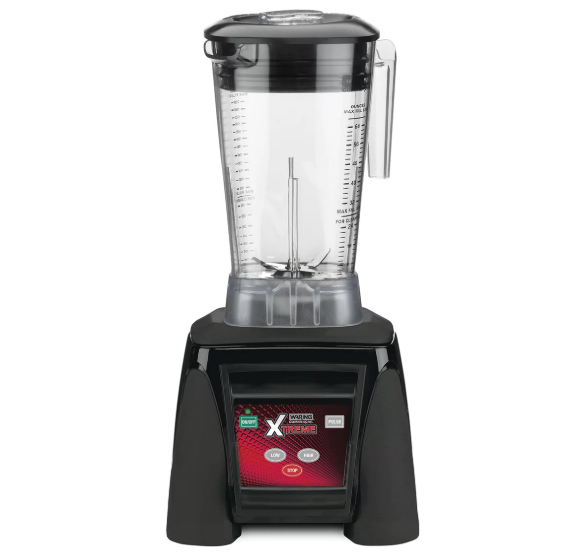
The Waring Commercial MX1050XTX Blender is a high-performance option for professional kitchens and heavy-duty home use. With a 3.5 HP motor, it handles tasks ranging from blending smoothies to crushing ice with ease. Its 64-ounce BPA-free Tritan container ensures safety and durability while being lighter than glass alternatives.
The blender’s variable speed control and straightforward toggle-switch interface provide precise control, suitable for both simple and complex recipes. Its stainless steel blades are engineered for efficiency, capable of processing tough ingredients smoothly. However, the machine operates loudly at high speeds, which may be disruptive in quieter settings.
From an environmental perspective, the MX1050XTX lacks explicit sustainability certifications, and its construction prioritizes performance over eco-friendly materials. Cleaning is convenient thanks to its dishwasher-safe components, though the base requires hand cleaning to avoid water damage.
- Pros:
- Powerful motor for professional-grade performance.
- BPA-free Tritan jar, lightweight and durable.
- Simple, intuitive controls.
- Easy-to-clean design with dishwasher-safe components.
- Cons:
- Loud operation, especially at higher speeds.
- No sustainability certifications or eco-conscious materials.
- Bulky design may not suit smaller spaces.
Comparison chart: Features, materials, price, and safety certifications
| Feature | Breville Fresh & Furious | Hamilton Beach Glass Jar | Oster Glass Jar | BLACK+DECKER PowerCrush | Dash Quest | Vitamix Blender | Tribest Greenstar Elite Juicer | Waring MX1050XTX |
|---|---|---|---|---|---|---|---|---|
| Main Material | BPA-free plastic pitcher | Tempered glass | BPA-free glass | Glass | BPA-free plastic | BPA-free plastic | BPA-free plastic and stainless steel | BPA-free Tritan |
| Motor Power | 1100 watts | Compatible with Hamilton Beach bases | N/A (jar only) | 700 watts | 1.5 HP | High-performance | Twin-gear extraction | 3.5 HP |
| Capacity | Standard pitcher | N/A (dependent on compatible base) | 6 cups | 6 cups | Small (suitable for personal use) | Large | N/A | 64 ounces |
| Blades | Surgical-grade stainless steel | N/A | N/A | Quad-pro blade technology | Standard | Durable stainless steel | Stainless steel | Stainless steel |
| Eco-Friendly Features | Recyclable packaging; BPA-free | Recyclable glass | Fully recyclable glass | Durable glass jar | Energy-efficient | Durable materials, repairable | BPA-free; minimal oxidation with twin-gear | Dishwasher-safe components |
| Noise Level | Quiet operation | N/A | N/A | Standard | Quiet | Relatively loud | Quiet | Loud |
| Special Features | Kinetix blade system; LCD auto-timer | Clear measurement markings | Stain-resistant; dishwasher-safe | Multiple presets; dishwasher-safe | Compact and lightweight | Versatile; self-cleaning | Juice stays fresh longer due to low oxidation | Professional-grade performance |
| Price Point | Higher | Affordable | Affordable | Budget-friendly | Budget-friendly | Premium | Premium | Premium |
| Cons | Lacks take-back program; limited compostable parts | Limited information on sustainability | Heavier; can break if dropped | Struggles with tougher ingredients | Limited motor power; small capacity | Expensive; loud | Expensive; time-intensive cleaning | Loud; lacks sustainability certifications |
| Best For | Everyday and high-performance blending | Eco-conscious consumers seeking glass jars | Families or frequent blender users | Light to medium blending tasks | Personal use or small kitchens | Health-conscious families; versatile cooking | Health enthusiasts prioritizing nutrients | Professional kitchens or heavy-duty use |
Why Choose a Non-Toxic Blender?
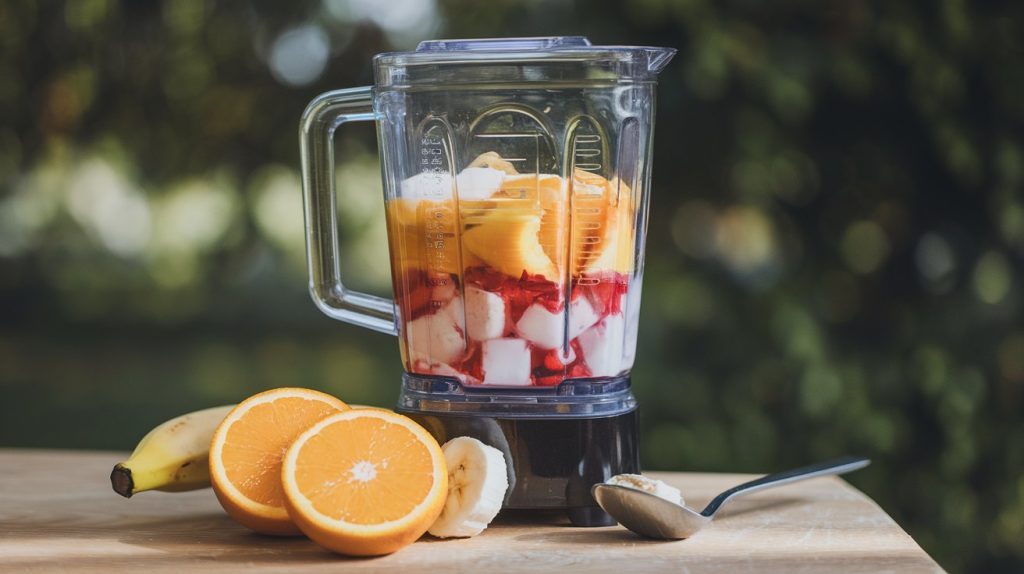
The Dangers of Toxic Materials in Traditional Blenders
Many traditional blenders are made with materials that can leach harmful chemicals into your food and drinks, especially when exposed to heat or acidic ingredients. Some of the most concerning materials include:
- BPA (Bisphenol A): A chemical commonly found in polycarbonate plastics and epoxy resins. BPA can leach into food and beverages, particularly when exposed to heat, and has been linked to hormone disruption.
- Phthalates: These chemicals are often used to make plastics flexible and durable. Unfortunately, phthalates can also interfere with the endocrine system, potentially causing reproductive and developmental issues.
- Other Harmful Chemicals: Some blenders may contain heavy metals or other toxic substances in their blades, housing, or seals, which can contaminate your food over time.
Health Risks Associated with Prolonged Exposure
Using a blender that contains toxic materials isn’t just an occasional risk—it can lead to serious health problems over time. Prolonged exposure to these substances has been linked to:
- Hormonal Imbalances: Chemicals like BPA and phthalates can mimic or interfere with natural hormones in the body, disrupting normal functions.
- Increased Cancer Risk: Certain toxic chemicals are considered carcinogens, raising the risk of cancer with long-term exposure.
- Developmental and Reproductive Issues: Pregnant women and children are particularly vulnerable to the harmful effects of these toxins, which can interfere with growth and development.
- Immune System Suppression: Continuous exposure to harmful substances can weaken the immune system, making the body more susceptible to illnesses.
Benefits of Non-Toxic Blenders
Investing in a non-toxic blender is a proactive step toward a healthier lifestyle. Here’s why they’re worth considering:
Safe for Food Preparation
- Chemical-Free Construction: eco-friendly blenders are typically made from high-quality, food-safe materials such as glass, stainless steel, or BPA-free plastics. These materials ensure that no harmful substances leach into your food, even when blending hot or acidic ingredients.
- Durability Without Risk: Many non-toxic models feature robust designs that resist wear and tear without compromising safety, providing long-lasting performance.
Eco-Friendly and Sustainable
- Environmentally Conscious Materials: Non-toxic blenders are often made with eco-friendly materials that are easier to recycle or biodegrade, reducing your carbon footprint.
- Energy Efficiency: Many models are designed with energy-saving features, contributing to a more sustainable kitchen.
- Promotes a Plastic-Free Lifestyle: By choosing materials like glass or stainless steel, you can significantly reduce your reliance on plastic products.
Switching to a non-toxic blender isn’t just a decision for better health; it’s also a step toward a greener, more sustainable future.
Are Blenders Toxic?
Blenders are a kitchen essential, but many people are unaware of the potential risks associated with some models. While blenders might seem like a straightforward appliance, their materials can significantly impact your health and safety. Here, we’ll explore the materials commonly used in blenders, how harmful chemicals can leach into your food, and clarify common misconceptions about blender safety.
Overview of Materials Commonly Used in Blenders
Blenders are constructed from a variety of materials, including:
- Plastics: Many blender jars and lids are made from plastic due to its lightweight and shatter-resistant properties. However, not all plastics are created equal. Some contain BPA (Bisphenol A) or phthalates, which are known to pose health risks.
- Glass: Glass jars are a popular non-toxic alternative, as they do not leach chemicals into food. They are sturdy, durable, and easy to clean, though they may be more prone to breaking.
- Stainless Steel: Often used for high-performance or professional-grade blenders, stainless steel is non-toxic, highly durable, and resistant to chemical reactions.
- Rubber and Silicone: Used in seals and gaskets, these materials may contain additives that could degrade over time, especially with exposure to heat or acidic foods.
- Blades and Internal Components: While most blades are made from stainless steel, some lower-quality models may use materials with trace amounts of heavy metals or harmful coatings.
How Harmful Chemicals Leach into Food
When blenders are made from toxic materials, there are several ways chemicals can leach into your food:
- Heat Exposure:
- Blending hot liquids, such as soups or sauces, can cause plastic components to release chemicals like BPA or phthalates into the food.
- Acidic Ingredients:
- Acidic foods, such as tomatoes, citrus fruits, or vinegar-based mixtures, can accelerate the breakdown of harmful chemicals, leading to increased leaching.
- Wear and Tear:
- Over time, scratches, cracks, or degradation in materials can create more opportunities for chemicals to migrate into food.
- Improper Cleaning:
- Using abrasive cleaning tools or harsh chemicals can damage protective coatings and exacerbate leaching risks.
Common Misconceptions About Blender Safety
Despite growing awareness about toxins in kitchen appliances, several misconceptions persist regarding blender safety:
- “All Plastics Are Safe”: Many people assume that any plastic used in food preparation is inherently safe. However, without labels like BPA-free or certifications from trusted organizations, there’s no guarantee that a plastic blender jar is non-toxic.
- “Only Heat Causes Leaching”: While heat is a significant factor, harmful chemicals can also leach into food at room temperature, especially when acidic ingredients are involved or the blender is worn.
- “Glass Blenders Are Fragile and Impractical”: While it’s true that glass jars can break if mishandled, modern designs use tempered glass, which is highly durable and safer for daily use.
- “Stainless Steel Blenders Alter Food Taste”: High-quality stainless steel is inert and does not affect the flavor or composition of food, making it an excellent choice for those seeking a non-toxic option.
- “Non-Toxic Equals Expensive”: While some premium non-toxic blenders can be costly, there are affordable options made with safe materials. Investing in a environmentally-friendly blender pays off by protecting your health and providing a durable appliance.
How to Identify a Non-Toxic Blender
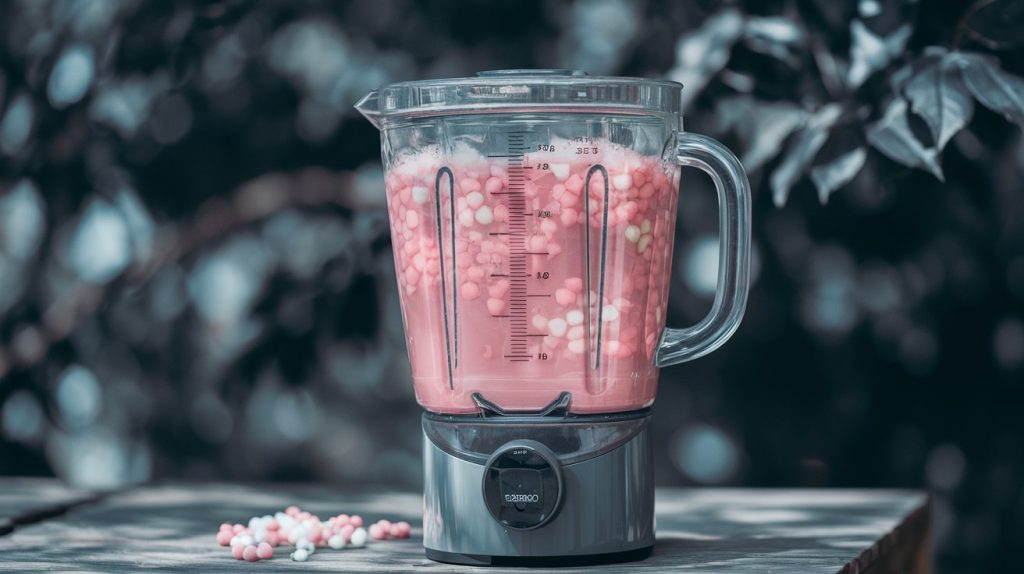
Selecting a non-toxic blender requires understanding the certifications, materials, and design features that ensure safety. By knowing what to look for—and what to avoid—you can confidently choose a blender that prioritizes your health and the environment.
Key Certifications to Look For
Certifications are a reliable way to determine if a blender is made from non-toxic and eco-friendly materials. Here are the most important ones:
1. BPA-Free Certification
- What It Means: Products labeled as BPA-free are free from bisphenol A, a chemical commonly found in plastics that can leach into food and beverages.
- Why It Matters: BPA is a known endocrine disruptor linked to hormonal imbalances, fertility issues, and increased cancer risk.
- How to Check: Look for labels explicitly stating “BPA-free” on the packaging or in the product description. Brands that emphasize non-toxic designs often highlight this feature prominently.
2. FDA-Approved Food-Safe Materials
- What It Means: The U.S. Food and Drug Administration (FDA) approves materials that are safe for food contact, ensuring no harmful chemicals will migrate into food or beverages.
- Why It Matters: FDA approval signals that the product meets stringent safety standards for food preparation.
- How to Check: Check for labels like “FDA-approved” or “meets FDA food-grade standards” in the product details.
3. Eco-Friendly Manufacturing Certifications
- What It Means: Certifications such as Green Seal or Energy Star indicate that a blender was produced with sustainable practices, using recyclable or renewable materials.
- Why It Matters: Eco-friendly products reduce environmental impact, aligning with a healthier, toxin-free lifestyle.
- How to Check: Look for certifications such as ISO 14001, Green Seal, or information about recycled content in the product’s materials.
Red Flags to Avoid
When shopping for a blender, avoid these warning signs that could indicate the presence of harmful materials or poor-quality construction:
1. Absence of BPA-Free Labeling
- If a plastic blender jar doesn’t explicitly state that it’s BPA-free, assume it may contain BPA. Reputable brands usually highlight this safety feature.
2. Overuse of Plastic Components
- While some BPA-free plastics are safe, a blender with excessive plastic parts—especially seals, blades, or housing—may degrade faster, posing a risk of chemical leaching.
3. Cheap and Unverified Materials
- Be cautious of blenders that use vague terms like “high-quality plastic” or lack detailed material information. These often indicate lower manufacturing standards.
4. Strong Chemical Odors
- If a blender emits a noticeable plastic or chemical smell, this could suggest off-gassing from low-quality or potentially toxic materials.
5. No Certifications or Third-Party Testing
- Blenders without recognizable certifications or endorsements from trusted organizations may not meet safety or eco-friendly standards.
Checklist for Identifying a Non-Toxic Blender
When shopping, use this quick checklist to ensure you’re selecting a truly non-toxic blender:
| Feature | What to Check For |
|---|---|
| Materials | Glass, stainless steel, or BPA-free plastic |
| Certifications | BPA-free, FDA-approved, eco-friendly labels |
| Construction | Minimal plastic parts, durable materials |
| Brand Transparency | Clear details about materials and testing |
| No Red Flags | Avoids cheap plastics, strong odors, and vague claims |
By focusing on these criteria, you can confidently choose a blender that supports a safer, healthier kitchen while reducing your environmental impact. Up next, we’ll explore the top non-toxic blenders on the market to help you make an informed purchase!
Best Practices for Using Non-Toxic Blenders
Even with a non-toxic blender, adopting the right practices ensures safe use and maximizes the lifespan of your appliance. Here are some essential tips to avoid toxic exposure during use and maintain your blender for years of reliable, healthy performance.
Tips to Avoid Toxic Exposure During Use
1. Avoid Blending Hot or Acidic Foods in Plastic Jars
- Why It Matters: Even BPA-free plastic jars can degrade over time, especially when exposed to high temperatures or acidic ingredients like tomatoes and citrus. This increases the risk of leaching.
- What to Do Instead: Use glass or stainless steel jars for hot or acidic blends. These materials are non-reactive and resistant to heat, ensuring no chemicals leach into your food.
2. Let Hot Foods Cool Before Blending
- Why It Matters: Pouring boiling liquids into a blender—especially one with plastic components—can stress the materials, leading to warping or chemical release.
- What to Do Instead: Allow soups or sauces to cool slightly before transferring them to the blender. If you need to blend while still warm, choose a blender specifically designed for hot foods, such as one with a vented lid or a heat-resistant container.
3. Avoid Blending High-Fat Ingredients in Plastic Containers
- Why It Matters: Fats can interact with certain plastics, especially under friction or heat, increasing the chance of chemical leaching.
- What to Do Instead: For recipes involving high-fat ingredients like nut butters, oils, or creams, opt for a blender with a glass or stainless steel jar.
Cleaning and Maintenance for Longevity and Safety
Keeping your blender clean and well-maintained not only ensures optimal performance but also reduces the risk of material degradation.
1. Clean Immediately After Use
- Why It Matters: Allowing food to sit in the blender can cause stains, odors, and build-up that weaken materials over time.
- How to Do It: Rinse the jar immediately with warm water. For thorough cleaning, add a few drops of mild dish soap and warm water to the blender, then run it for a few seconds before rinsing again.
2. Avoid Harsh Chemicals and Abrasive Cleaners
- Why It Matters: Harsh cleaning agents or abrasive scrubbers can scratch or damage the surface of your blender, especially if it’s made from plastic.
- What to Do Instead: Use a soft sponge and mild detergent. For tough stains, let the jar soak in a mixture of water, baking soda, and vinegar before gently scrubbing.
3. Check and Replace Worn Components
- Why It Matters: Over time, seals, gaskets, and blades can wear down, leading to leaks or reduced performance. Worn components might also harbor bacteria or other contaminants.
- What to Do: Regularly inspect these parts and replace them as needed. Many blender brands offer replacement parts for common wear items.
4. Store Safely
- Why It Matters: Improper storage can expose your blender to dust, moisture, or accidental damage.
- How to Do It: Store your blender in a clean, dry place. If possible, keep it assembled to prevent losing small components like lids or seals.
The Eco-Friendly Angle: Non-Toxic Blenders and Sustainability
Incorporating eco-conscious decisions into your kitchen can be as simple as choosing the right blender. Non-toxic blenders go beyond promoting personal health—they contribute to a greener, more sustainable planet. This section delves into how these appliances enhance environmental responsibility, highlighting energy-efficient models and tips for recycling old blenders responsibly.
How Non-Toxic Blenders Contribute to a Greener Kitchen
Non-toxic blenders are designed with materials and processes that minimize harm to both humans and the environment. Here’s how they support sustainability:
- BPA-Free Materials: Many non-toxic blenders use BPA-free plastics or glass containers, reducing reliance on harmful, non-recyclable materials.
- Long-Lasting Durability: High-quality construction ensures these blenders last longer, reducing the frequency of replacements and the resulting waste.
- Non-Reactive Components: By avoiding toxic coatings or harmful metals, environmentally-friendly blenders prevent contamination of both food and the ecosystem during disposal.
- Ethical Manufacturing: Many brands producing non-toxic blenders prioritize eco-friendly manufacturing practices, using less energy and fewer pollutants.
These features collectively make non-toxic blenders a smart choice for environmentally conscious consumers aiming to reduce their carbon footprint.
Energy-Efficient Models to Consider
Energy efficiency is a key factor in creating a sustainable kitchen. Modern blenders have come a long way in reducing power consumption without compromising performance. Here are some top energy-efficient non-toxic blender models worth considering:
- Vitamix E310 Explorian Blender
- Features a long-lasting motor that optimizes energy use.
- BPA-free container made from durable, recyclable materials.
- Designed for efficiency, with low standby energy consumption.
- Ninja Professional Plus Blender
- Offers Auto-iQ technology to minimize energy waste by blending intelligently.
- Uses a combination of BPA-free plastics and eco-conscious packaging.
- Blendtec Total Classic Original Blender
- Built to last with a high-efficiency motor that minimizes energy usage.
- Comes with recyclable and BPA-free containers.
- NutriBullet Pro 1000
- Compact and efficient design reduces power usage.
- Includes eco-friendly materials for both the base and cups.
These models prove that high performance doesn’t have to come at the cost of excessive energy consumption.
Recycling Old Blenders Responsibly
Upgrading your blender to a non-toxic, energy-efficient model doesn’t mean your old appliance has to end up in a landfill. Here’s how you can dispose of it responsibly:
- Check Manufacturer Recycling Programs: Many companies, like Vitamix and Ninja, offer take-back or recycling programs for their products.
- Donate Usable Blenders: If your blender is still functional, consider donating it to local shelters, thrift stores, or community organizations.
- Recycle Through E-Waste Facilities: Non-working blenders can often be recycled at local e-waste centers, where components like metal, plastic, and electronics are properly sorted and reused.
- Upcycle for Creative Projects: Use parts like the motor or glass jar for DIY projects, such as creating planters or storage containers.
By ensuring your old blender is responsibly handled, you help reduce waste and promote a circular economy.
FAQs About Non-Toxic Blenders
When selecting a blender for your kitchen, understanding the finer details can make all the difference. Below, we address some common questions about non-toxic blenders to help you make an informed choice.
Are all BPA-free blenders non-toxic?
No, not all BPA-free blenders are completely non-toxic. While BPA-free plastics eliminate one harmful chemical, other factors determine a blender’s overall safety:
- Material Composition: BPA-free plastics can still contain other harmful compounds, such as phthalates or PVC. Always check for certifications or labels indicating the absence of these materials.
- Coatings and Components: Look out for toxic coatings on metal parts or blades. High-quality non-toxic blenders use food-grade stainless steel or other non-reactive materials.
- Heat Resistance: Poor-quality BPA-free plastics can release toxins when exposed to high heat. Consider alternatives like glass or stainless steel jars for blending hot ingredients.
Can I use a plastic blender safely?
Yes, you can use a plastic blender safely, but with precautions:
- Opt for High-Quality BPA-Free Plastic: Ensure the blender’s jar is made from food-grade, heat-resistant plastic to minimize the risk of leaching chemicals.
- Avoid Hot Liquids: Even with BPA-free plastics, avoid blending very hot liquids to prevent potential chemical breakdown.
- Inspect Regularly: Over time, plastic can degrade or develop scratches, which may harbor bacteria or release particles. Replace worn-out containers promptly.
For ultimate peace of mind, consider glass or stainless steel containers, which are inherently non-toxic and durable.
How do I clean a glass or stainless steel blender?
Cleaning a glass or stainless steel blender is straightforward and keeps it safe for long-term use:
- Basic Cleaning Method:
- Add warm water and a few drops of mild dish soap to the blender jar.
- Run the blender on low for 30 seconds to a minute.
- Rinse thoroughly with clean water and allow to air dry.
- Tough Stains and Odors:
- Use a paste made from baking soda and water to scrub stubborn stains in glass jars.
- For stainless steel, mix vinegar and water for a gentle yet effective cleaning solution.
- Blades and Gaskets:
- Carefully disassemble removable parts and clean them individually to prevent residue buildup.
- Use a small brush to clean around the blades without risking injury.
- Avoiding Damage:
- Don’t use abrasive sponges or harsh cleaners on glass, as they can cause scratches.
- Keep stainless steel jars dry after washing to prevent water spots or corrosion.